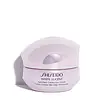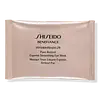What's inside
What's inside
 Key Ingredients
Key Ingredients

 Benefits
Benefits

 Concerns
Concerns

 Ingredients Side-by-side
Ingredients Side-by-side

Water
Skin ConditioningDimethicone
EmollientButylene Glycol
HumectantGlycerin
HumectantAlcohol
AntimicrobialDimethicone/Vinyl Dimethicone Crosspolymer
Skin ConditioningMyristyl Myristate
EmollientPetrolatum
EmollientHydrogenated Polydecene
EmollientBehenyl Alcohol
EmollientCetyl Ethylhexanoate
EmollientGlyceryl Stearate Se
EmulsifyingPotassium Methoxysalicylate
BleachingMethyl Methacrylate Crosspolymer
Stearyl Alcohol
EmollientDimethylacrylamide/Sodium Acryloyldimethyltaurate Crosspolymer
Polysorbate 60
EmulsifyingPEG-40 Stearate
EmulsifyingTocopheryl Acetate
AntioxidantPhenoxyethanol
PreservativeCI 77891
Cosmetic ColorantParfum
MaskingSorbitan Tristearate
EmulsifyingTrisodium EDTA
PEG-10 Dimethicone
Skin ConditioningSodium Citrate
BufferingOryzanol
Skin Conditioning2-O-Ethyl Ascorbic Acid
Skin ConditioningMica
Cosmetic ColorantSilica
AbrasiveXanthan Gum
EmulsifyingSodium Metaphosphate
BufferingLimonene
PerfumingCitric Acid
BufferingPEG/PPG-14/7 Dimethyl Ether
Skin ConditioningAluminum Hydroxide
EmollientBenzyl Benzoate
AntimicrobialButylphenyl Methylpropional
PerfumingCI 77491
Cosmetic ColorantLinalool
PerfumingSodium Hyaluronate
HumectantCitronellol
PerfumingCrataegus Monogyna Flower Extract
Skin ConditioningTocopherol
AntioxidantWater, Dimethicone, Butylene Glycol, Glycerin, Alcohol, Dimethicone/Vinyl Dimethicone Crosspolymer, Myristyl Myristate, Petrolatum, Hydrogenated Polydecene, Behenyl Alcohol, Cetyl Ethylhexanoate, Glyceryl Stearate Se, Potassium Methoxysalicylate, Methyl Methacrylate Crosspolymer, Stearyl Alcohol, Dimethylacrylamide/Sodium Acryloyldimethyltaurate Crosspolymer, Polysorbate 60, PEG-40 Stearate, Tocopheryl Acetate, Phenoxyethanol, CI 77891, Parfum, Sorbitan Tristearate, Trisodium EDTA, PEG-10 Dimethicone, Sodium Citrate, Oryzanol, 2-O-Ethyl Ascorbic Acid, Mica, Silica, Xanthan Gum, Sodium Metaphosphate, Limonene, Citric Acid, PEG/PPG-14/7 Dimethyl Ether, Aluminum Hydroxide, Benzyl Benzoate, Butylphenyl Methylpropional, CI 77491, Linalool, Sodium Hyaluronate, Citronellol, Crataegus Monogyna Flower Extract, Tocopherol
Water
Skin ConditioningButylene Glycol
HumectantPentaerythrityl Tetraethylhexanoate
EmollientDiphenylsiloxy Phenyl Trimethicone
Skin ConditioningGlycerin
HumectantDipropylene Glycol
HumectantPEG-60 Hydrogenated Castor Oil
EmulsifyingTocopheryl Acetate
AntioxidantPhenoxyethanol
PreservativeAlcohol
AntimicrobialCarbomer
Emulsion StabilisingSodium Citrate
BufferingParfum
MaskingBHT
AntioxidantSqualane
EmollientXanthan Gum
EmulsifyingPotassium Hydroxide
BufferingRetinol
Skin ConditioningPolysorbate 20
EmulsifyingCitric Acid
BufferingTrisodium EDTA
Magnesium Ascorbyl Phosphate
AntioxidantButylphenyl Methylpropional
PerfumingSapindus Mukorossi Peel Extract
Skin ConditioningLimonene
PerfumingLinalool
PerfumingUncaria Gambir Extract
AstringentCitronellol
PerfumingAlpha-Isomethyl Ionone
PerfumingPaeonia Suffruticosa Root Extract
Skin ProtectingGeraniol
PerfumingBenzyl Benzoate
AntimicrobialSodium Acetylated Hyaluronate
HumectantHydroxyproline
Skin ConditioningChlorella Vulgaris Extract
Skin ConditioningCI 75130
Cosmetic ColorantWater, Butylene Glycol, Pentaerythrityl Tetraethylhexanoate, Diphenylsiloxy Phenyl Trimethicone, Glycerin, Dipropylene Glycol, PEG-60 Hydrogenated Castor Oil, Tocopheryl Acetate, Phenoxyethanol, Alcohol, Carbomer, Sodium Citrate, Parfum, BHT, Squalane, Xanthan Gum, Potassium Hydroxide, Retinol, Polysorbate 20, Citric Acid, Trisodium EDTA, Magnesium Ascorbyl Phosphate, Butylphenyl Methylpropional, Sapindus Mukorossi Peel Extract, Limonene, Linalool, Uncaria Gambir Extract, Citronellol, Alpha-Isomethyl Ionone, Paeonia Suffruticosa Root Extract, Geraniol, Benzyl Benzoate, Sodium Acetylated Hyaluronate, Hydroxyproline, Chlorella Vulgaris Extract, CI 75130
Ingredients Explained
These ingredients are found in both products.
Ingredients higher up in an ingredient list are typically present in a larger amount.
Alcohol comes in many different forms. Different types of alcohol will have different effects on skin. This ingredient is usually an astringent alcohol.
These alcohols are drying on the skin. They may strip away your skin's natural oils and even damage your skin barrier. Astringent alcohols may also irritate skin.
Other types of astringent alcohols include:
According to the National Rosacea Society based in the US, you should be mindful of products with these alcohols in the top half of ingredients.
Any type of sanitizing product will have high amounts of alcohol to help kill bacteria and viruses.
Fatty alcohols come from plant oils such as coconut oil. These can help hydrate the skin and are non-irritating. Some fatty alcohols include cetyl and stearyl alcohol.
Learn more about AlcoholBenzyl Benzoate is usually created from the condensation of benzoic acid and benzyl alcohol. It is used as a preservative, solvent, and has a floral/balsamic scent in large amounts.
As a preservative, Benzyl Benzoate works against bacteria and fungus. It is often used to treat scabies and lice in medicine.
Solvents are used to keep ingredients together in a product. They can help dissolve ingredients to stable bases or help evenly distribute ingredients throughout the product.
Due to its fragrance, Benzyl Benzoate can be sensitizing and may cause contact dermatitis. It is a known EU allergen. We recommend speaking with a professional if you have any concerns.
Benzyl Benzoate can be naturally found in cranberries and peaches.
Learn more about Benzyl BenzoateButylene Glycol (or BG) is used within cosmetic products for a few different reasons:
Overall, Butylene Glycol is a safe and well-rounded ingredient that works well with other ingredients.
Though this ingredient works well with most skin types, some people with sensitive skin may experience a reaction such as allergic rashes, closed comedones, or itchiness.
Learn more about Butylene GlycolButylphenyl Methylpropional is a synthetic fragrance. You might know it as "lilial". The scent of this ingredient is floral-like and similar to the scent of lily flowers.
In March of 2022, the EU banned this ingredient in both rinse-off and leave-on products. This is because research found Butylphenyl Methylpropional to disrupt fertility in rats.
This ingredient is also a known EU allergen, meaning it is likely to cause an allergic reaction. Irritated skin can be damaging.
We always recommend speaking with a professional if you have any concerns or questions about this ingredient.
Learn more about Butylphenyl MethylpropionalCitric Acid is an alpha hydroxy acid (AHA) naturally found in citrus fruits like oranges, lemons, and limes.
Like other AHAs, citric acid can exfoliate skin by breaking down the bonds that hold dead skin cells together. This helps reveal smoother and brighter skin underneath.
However, this exfoliating effect only happens at high concentrations (20%) which can be hard to find in cosmetic products.
Due to this, citric acid is usually included in small amounts as a pH adjuster. This helps keep products slightly more acidic and compatible with skin's natural pH.
In skincare formulas, citric acid can:
While it can provide some skin benefits, research shows lactic acid and glycolic acid are generally more effective and less irritating exfoliants.
Most citric acid used in skincare today is made by fermenting sugars (usually from molasses). This synthetic version is identical to the natural citrus form but easier to stabilize and use in formulations.
Read more about some other popular AHA's here:
Learn more about Citric AcidCitronellol is used to add fragrance/parfum to a product. It is often derived from plants such as roses. In fact, it can be found in many essential oils including geranium, lavender, neroli, and more. The scent of Citronellol is often described as "fresh, grassy, and citrus-like".
Since the Citronellol molecule is already unstable, Citronellol becomes irritating on the skin when exposed to air.
Citronellol is a modified terpene. Terpenes are unsaturated hydrocarbons found in plants. They make up the primary part of essential oils.
Citronellol is not able to be absorbed into deeper layers of the skin. It has low permeability,
Citronellol is also a natural insect repellent.
Learn more about CitronellolGlycerin is already naturally found in your skin. It helps moisturize and protect your skin.
A study from 2016 found glycerin to be more effective as a humectant than AHAs and hyaluronic acid.
As a humectant, it helps the skin stay hydrated by pulling moisture to your skin. The low molecular weight of glycerin allows it to pull moisture into the deeper layers of your skin.
Hydrated skin improves your skin barrier; Your skin barrier helps protect against irritants and bacteria.
Glycerin has also been found to have antimicrobial and antiviral properties. Due to these properties, glycerin is often used in wound and burn treatments.
In cosmetics, glycerin is usually derived from plants such as soybean or palm. However, it can also be sourced from animals, such as tallow or animal fat.
This ingredient is organic, colorless, odorless, and non-toxic.
Glycerin is the name for this ingredient in American English. British English uses Glycerol/Glycerine.
Learn more about GlycerinLimonene is a fragrance that adds scent and taste to a formulation.
It's found in the peel oil of citrus fruits and other plants such as lavender and eucalyptus. The scent of limonene is generally described as "sweet citrus".
Limonene acts as an antioxidant, meaning it helps neutralize free radicals.
When exposed to air, oxidized limonene may sensitize the skin. Because of this, limonene is often avoided by people with sensitive skin.
The term 'fragrance' is not regulated in many countries. In many cases, it is up to the brand to define this term. For instance, many brands choose to label themselves as "fragrance-free" because they are not using synthetic fragrances. However, their products may still contain ingredients such as essential oils that are considered a fragrance.
Learn more about LimoneneLinalool is a fragrance and helps add scent to products. It's derived from common plants such as cinnamon, mint, citrus, and lavender.
Like Limonene, this ingredient oxidizes when exposed to air. Oxidized linalool can cause allergies and skin sensitivity.
This ingredient has a scent that is floral, spicy tropical, and citrus-like.
Learn more about LinaloolParfum is a catch-all term for an ingredient or more that is used to give a scent to products.
Also called "fragrance", this ingredient can be a blend of hundreds of chemicals or plant oils. This means every product with "fragrance" or "parfum" in the ingredients list is a different mixture.
For instance, Habanolide is a proprietary trade name for a specific aroma chemical. When used as a fragrance ingredient in cosmetics, most aroma chemicals fall under the broad labeling category of “FRAGRANCE” or “PARFUM” according to EU and US regulations.
The term 'parfum' or 'fragrance' is not regulated in many countries. In many cases, it is up to the brand to define this term.
For instance, many brands choose to label themselves as "fragrance-free" because they are not using synthetic fragrances. However, their products may still contain ingredients such as essential oils that are considered a fragrance by INCI standards.
One example is Calendula flower extract. Calendula is an essential oil that still imparts a scent or 'fragrance'.
Depending on the blend, the ingredients in the mixture can cause allergies and sensitivities on the skin. Some ingredients that are known EU allergens include linalool and citronellol.
Parfum can also be used to mask or cover an unpleasant scent.
The bottom line is: not all fragrances/parfum/ingredients are created equally. If you are worried about fragrances, we recommend taking a closer look at an ingredient. And of course, we always recommend speaking with a professional.
Learn more about ParfumPhenoxyethanol is a preservative that has germicide, antimicrobial, and aromatic properties. Studies show that phenoxyethanol can prevent microbial growth. By itself, it has a scent that is similar to that of a rose.
It's often used in formulations along with Caprylyl Glycol to preserve the shelf life of products.
Sodium Citrate is the sodium salts of citric acid. In skincare, it is used to alter pH levels and acts as a preservative.
Its main functions are to maintain the pH of a product and neutralize metal ions.
The acidity of our skin is maintained by our glands and skin biome; normal pH level of skin is slightly acidic (~4.75-5.5).
Being slightly acidic allows our skin to create an "acid mantle". This acid mantle is a thin barrier that protects our skin from bacteria and contaminants.
Learn more about Sodium CitrateTocopheryl Acetate is AKA Vitamin E. It is an antioxidant and protects your skin from free radicals. Free radicals damage the skin by breaking down collagen.
One study found using Tocopheryl Acetate with Vitamin C decreased the number of sunburned cells.
Tocopheryl Acetate is commonly found in both skincare and dietary supplements.
Learn more about Tocopheryl AcetateWe don't have a description for Trisodium EDTA yet.
Water. It's the most common cosmetic ingredient of all. You'll usually see it at the top of ingredient lists, meaning that it makes up the largest part of the product.
So why is it so popular? Water most often acts as a solvent - this means that it helps dissolve other ingredients into the formulation.
You'll also recognize water as that liquid we all need to stay alive. If you see this, drink a glass of water. Stay hydrated!
Learn more about WaterXanthan gum is used as a stabilizer and thickener within cosmetic products. It helps give products a sticky, thick feeling - preventing them from being too runny.
On the technical side of things, xanthan gum is a polysaccharide - a combination consisting of multiple sugar molecules bonded together.
Xanthan gum is a pretty common and great ingredient. It is a natural, non-toxic, non-irritating ingredient that is also commonly used in food products.
Learn more about Xanthan Gum